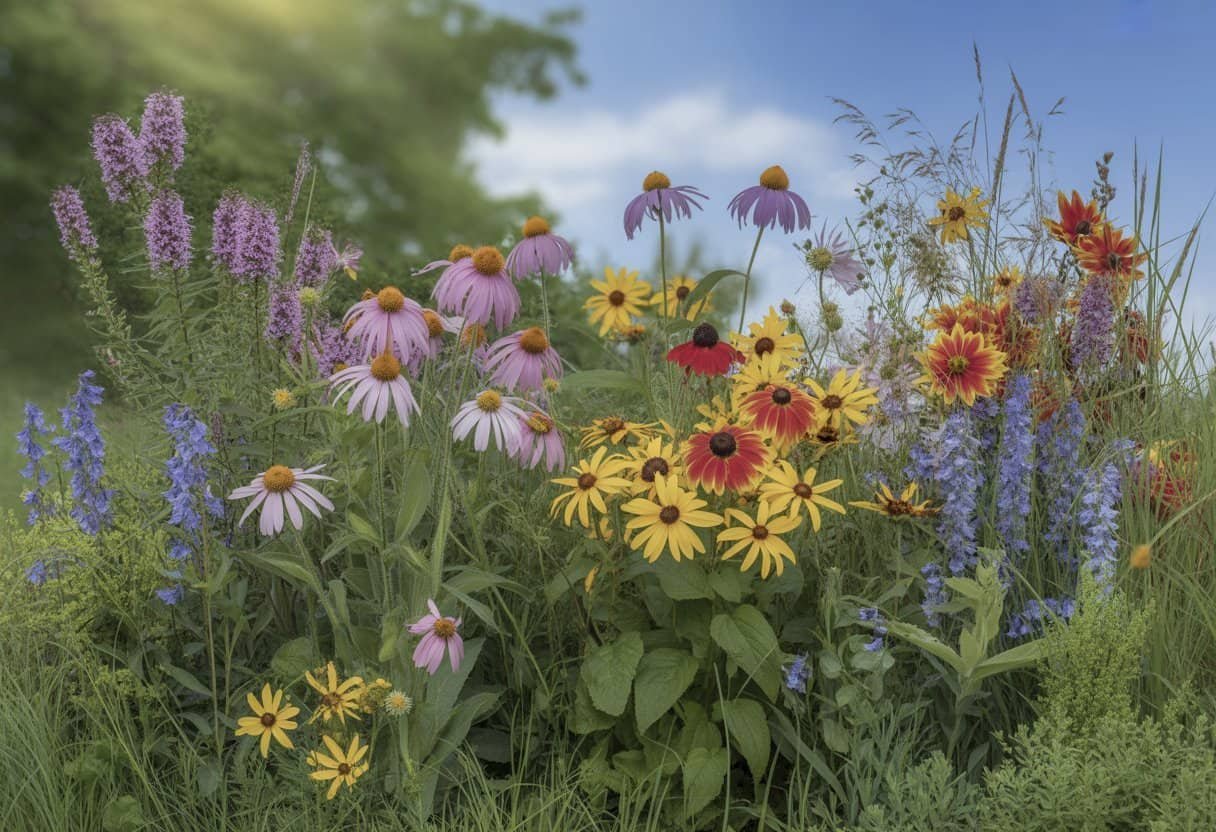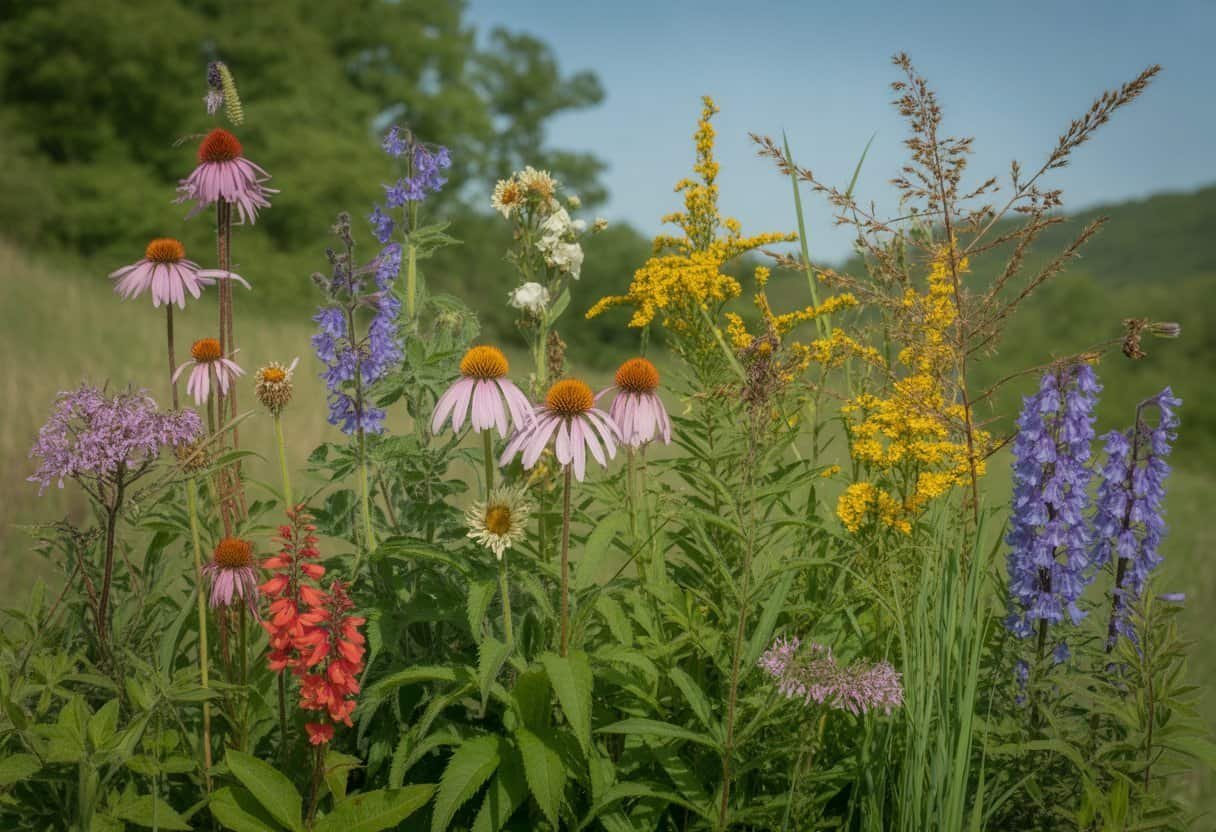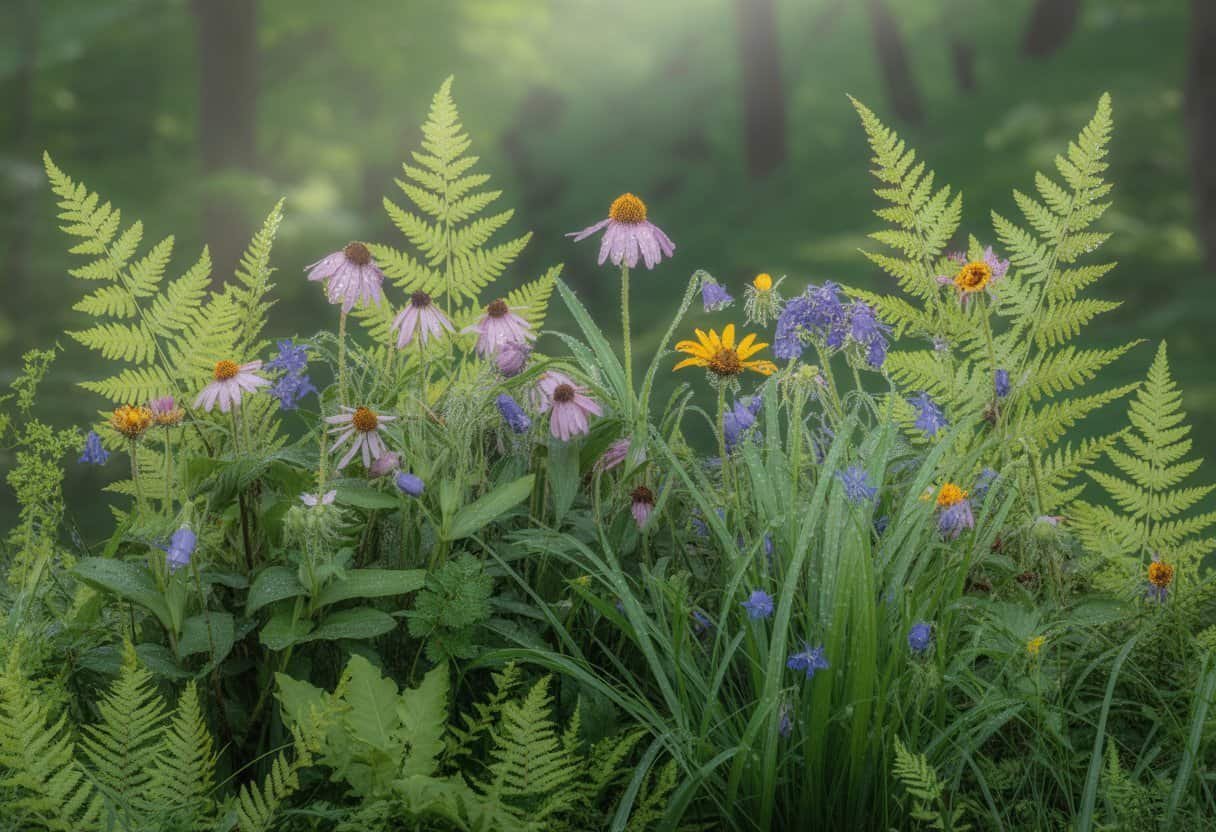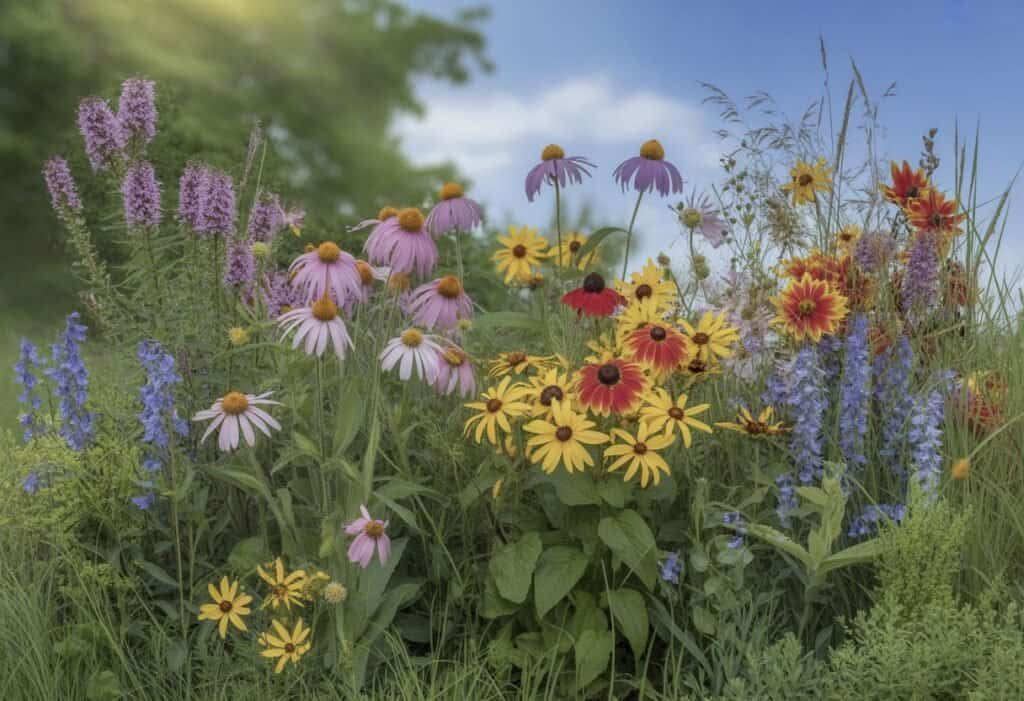Kentucky is home to a rich diversity of native plants that have evolved over thousands of years to thrive in our local soils and climate. These plants form the backbone of our natural ecosystems, providing food and shelter for local wildlife.
They create the beautiful landscapes we associate with the Bluegrass State. Native plants require less maintenance, water, and fertilizer than non-native species, making them an excellent choice for both conservation-minded and practical gardeners.

From the vibrant purple coneflower to the stately Kentucky coffeetree, our native plant species offer options for every garden setting. Many Kentucky natives display stunning seasonal changes, from spring blooms to dramatic fall colors.
They connect us to our state’s natural heritage while solving common landscape challenges like erosion control and drought resistance.
Key Takeaways
- Kentucky native plants support local wildlife, require less maintenance, and are adapted to thrive in our regional climate conditions.
- Including native wildflowers, trees, and shrubs in home landscapes helps preserve biodiversity while creating distinctive garden spaces.
- Native plant species can be sourced from specialized nurseries across the state and incorporated into gardens of any size or style.
Understanding Kentucky Native Plants
Kentucky’s landscape features a rich diversity of native plants that have evolved in the region over thousands of years. These plants are perfectly adapted to local conditions and provide benefits to both wildlife and humans.
Definition and Importance
Native plants are species that occur naturally in a region without human introduction. In Kentucky, these include trees like the Kentucky coffeetree, wildflowers such as the Kentucky lady’s slipper, and grasses like little bluestem.
These plants have developed alongside local soil conditions, rainfall patterns, and seasonal changes. Native plants need less maintenance than non-native species.
They typically use less water, fertilizer, and pest control once established. This makes them cost-effective and environmentally friendly for gardens and landscapes.
Kentucky’s native plants also preserve the state’s natural heritage. Many species hold cultural significance and historical value.
Some have been used for food, medicine, and crafts by indigenous peoples and early settlers.
Role in Local Ecosystems
Native plants form the foundation of Kentucky’s ecosystems. They provide essential food and shelter for local wildlife, including pollinators like bees and butterflies.
Many Kentucky animals have evolved alongside these plants and depend specifically on them for survival. These plants maintain healthy soil systems.
Their deep roots prevent erosion, especially in Kentucky’s hilly regions and along waterways. They also improve water quality by filtering runoff and reducing flooding.
Native plant communities in Kentucky create diverse habitats that support complex food webs. From forests to prairies to wetlands, these plants create the structure that allows other organisms to thrive.
Native plants have adapted to Kentucky’s weather patterns over millennia and can better withstand local environmental stresses compared to introduced species.
Key Species of Kentucky Native Plants

Kentucky’s landscape is home to a diverse array of native plants that thrive in the state’s climate and soil conditions. These native species provide essential habitat for wildlife while offering beautiful options for sustainable landscaping.
Notable Trees and Shrubs
Eastern Redbud (Cercis canadensis) stands out as one of Kentucky’s most beloved native trees. Its vibrant pink-purple flowers bloom in early spring before its heart-shaped leaves appear.
Flowering Dogwood brightens Kentucky forests with its showy white blooms in spring. This small tree grows well in partially shaded areas and provides berries for birds in fall.
Red Maple (Acer rubrum) offers spectacular fall color with its brilliant red foliage. This adaptable tree can reach heights of 40-60 feet and thrives in various soil conditions.
Buttonbush (Cephalanthus occidentalis) excels in wet areas. Its unique spherical white flowers attract butterflies and other pollinators during summer.
Spicebush works well as an understory shrub in woodland gardens. It features aromatic foliage and small yellow flowers that bloom before leaves emerge in spring.
Popular Wildflowers
Wild Hydrangea (Hydrangea arborescens) produces clusters of white flowers that brighten shaded woodland areas. This native shrub blooms from June through September.
Wild Ginger offers heart-shaped leaves that create an attractive groundcover in shady spots. Its unusual maroon flowers appear at ground level in spring, often hidden beneath the foliage.
Other notable Kentucky wildflowers include:
- Purple Coneflower
- Black-Eyed Susan
- Cardinal Flower
- Great Blue Lobelia
- Butterfly Weed
These natives require minimal care once established and support local pollinators. Many bloom for extended periods, adding color to gardens throughout the growing season.
Ornamental Vines and Ferns
Coral Honeysuckle (Lonicera sempervirens), also known as Trumpet Honeysuckle, produces tubular red flowers that attract hummingbirds. Unlike invasive Japanese honeysuckle, this native vine behaves well in gardens while providing wildlife value.
Virginia Creeper climbs trees and structures with its adhesive discs. This versatile vine offers spectacular red fall color and blue-black berries that birds enjoy.
Kentucky’s native ferns thrive in shady, moist locations. Christmas Fern remains evergreen year-round, while Maidenhair Fern displays delicate fronds on black stems.
These ferns add texture and interest to woodland gardens. Crossvine produces trumpet-shaped orange-red flowers similar to trumpet vine but with less aggressive growth.
It climbs by tendrils and can reach 50 feet in length when supported.
Wildflowers and Ferns of Kentucky

Kentucky’s landscape blooms with diverse native wildflowers and ferns that have adapted to the state’s climate and soil conditions. These plants provide essential habitat for pollinators and add natural beauty to Kentucky’s woodlands, meadows, and stream banks.
Spring-Blooming Varieties
Virginia Bluebells (Mertensia virginica) carpet Kentucky’s moist woodlands with bell-shaped blue flowers from March to May. These delicate wildflowers prefer partial shade and rich, well-drained soil.
Black-Eyed Susan (Rudbeckia hirta) brightens Kentucky fields with golden-yellow petals surrounding a dark brown center. This drought-tolerant native blooms in late spring and continues flowering into summer.
Early spring brings the unfurling of fiddlehead ferns. The Christmas Fern and Maidenhair Fern are common Kentucky natives that add texture to shady forest floors.
Popular Spring Kentucky Natives:
- Wild Geranium (pink-purple blooms)
- Jack-in-the-Pulpit (unique hooded flowers)
- Wild Columbine (red and yellow nodding blooms)
Summer and Fall Highlights
Purple Coneflower (Echinacea purpurea) stands tall in summer meadows with distinctive purple petals and raised center cones. This herbaceous perennial attracts butterflies and withstands Kentucky’s hot summers.
Cardinal Flower (Lobelia cardinalis) produces striking red blooms in late summer along stream banks and moist areas. Hummingbirds frequently visit these brilliant red flowers.
Goldenrod species burst with yellow flower clusters in late summer through fall. Goldenrod doesn’t cause hay fever and serves as crucial late-season pollinator food.
Kentucky’s native ferns continue providing greenery through summer and fall. The Royal Fern and Sensitive Fern thrive in moist areas, while the Hay-scented Fern adapts to drier woodland edges.
Utilizing Kentucky Native Plants in Landscaping
Kentucky native plants offer practical and beautiful options for home landscaping projects. These plants have adapted to local conditions over thousands of years.
They make ideal choices for gardens throughout the Bluegrass State.
Benefits for Gardens
Native plants require less maintenance once established in a garden setting. They typically need less water than non-native species because they’ve adapted to Kentucky’s natural rainfall patterns.
This saves time, money, and resources. Native plantings support local wildlife by providing natural food and shelter.
Birds, butterflies, and beneficial insects depend on these plants for survival. A garden with native Kentucky plants might attract colorful songbirds and monarch butterflies.
Soil health improves with native plants. Their extensive root systems prevent erosion and help rainwater soak into the ground.
This reduces runoff and helps replenish groundwater supplies. Native gardens also connect homeowners to Kentucky’s natural heritage.
Plants like purple coneflower and black-eyed Susan showcase the region’s botanical diversity right in the backyard.
Best Practices for Design
Group plants with similar needs together to create effective native gardens. Consider sunlight, moisture requirements, and soil conditions when placing plants.
Create year-round interest by selecting plants with different blooming times. Spring beauties and trillium provide early color, while asters and goldenrod offer autumn appeal.
Layer plants by height to create visual depth. Place taller plants like Joe-Pye weed toward the back, medium-height plants like bee balm in the middle, and ground covers like wild ginger at the front.
Include a variety of plant types:
- Trees: Redbud, dogwood, oak
- Shrubs: Spicebush, serviceberry, elderberry
- Wildflowers: Black-eyed Susan, wild columbine
- Grasses: Little bluestem, switchgrass
Allow some areas to grow naturally for a meadow-like appearance. This reduces maintenance and creates habitat diversity.
Choosing the Right Species
Match plants to your specific garden conditions. Kentucky’s varied landscape includes mountain regions, river valleys, and limestone plains, each supporting different native species.
Sun-loving plants for dry sites:
- Butterfly weed
- Purple coneflower
- Black-eyed Susan
Shade-tolerant species for woodland gardens:
- Wild ginger
- Solomon’s seal
- Foam flower
Consider the mature size of plants to avoid overcrowding. Some Kentucky natives like pawpaw trees need significant space, while others like wild strawberry stay compact.
Native plant sales, local nurseries, and organizations like the Kentucky Native Plant Society offer resources for finding authentic local species. Avoid cultivars when possible, as they may not provide the same ecological benefits as true natives.
Start with easy-to-grow species like butterfly milkweed or New England aster to build confidence before trying more specialized plants.
Supporting Pollinators and Wildlife
Kentucky’s native plants play a crucial role in sustaining local ecosystems by providing food and habitat for pollinators and wildlife. These natural relationships have evolved over thousands of years, creating interdependent systems that keep our environment healthy.
Top Pollinator Plants
Purple coneflower (Echinacea purpurea) stands out as one of Kentucky’s most valuable pollinator plants. Its bright purple blooms attract butterflies, bees, and even hummingbirds throughout summer.
Butterfly milkweed (Asclepias tuberosa) provides essential habitat for monarch butterflies. The plant serves as both food source and nursery for monarch caterpillars while its vibrant orange flowers offer nectar to adult butterflies.
Wild bergamot (Monarda fistulosa) draws bees, butterflies, and hummingbirds with its fragrant lavender flowers. This hardy native thrives in various conditions across Kentucky.
Other excellent pollinator plants include:
- Joe-Pye weed (Eutrochium purpureum)
- New England aster (Symphyotrichum novae-angliae)
- Black-eyed Susan (Rudbeckia hirta)
- Blazing star (Liatris spicata)
Creating Pollinator Gardens
Successful pollinator gardens use plants that bloom throughout the growing season. Early spring bloomers like Virginia bluebells provide crucial nectar, while fall asters support late-season pollinators.
Location matters. Choose sunny spots for most pollinator plants. Some natives like woodland phlox thrive in partial shade.
Group similar plants together in clusters of at least three. This creates visible “landing pads” for flying pollinators.
Avoid pesticides in pollinator gardens. Even organic varieties can harm beneficial insects and disrupt the ecosystem.
Water features add value to pollinator gardens. A simple birdbath or shallow dish with stones gives butterflies and bees a place to drink during dry periods.
Encouraging Local Wildlife
Native plants offer more than nectar. Berry-producing shrubs like serviceberry and elderberry feed birds and provide nesting sites.
Oak trees support over 500 species of caterpillars. These caterpillars become food for nesting birds.
A single chickadee family needs thousands of caterpillars to raise one brood of young. Planting oaks can help meet this need.
Leave the leaves. Allow fallen leaves to remain under trees and shrubs. This creates natural habitat for overwintering insects and small mammals.
Create brush piles with fallen branches to provide shelter for birds, rabbits, and other small animals. Place these in quiet corners of your yard.
Dead trees, when safely left standing, become vital wildlife habitats. These “snags” provide nesting cavities for woodpeckers, chickadees, and other cavity-nesting birds.
Sourcing and Planting Kentucky Native Plants
Finding quality Kentucky native plants requires knowing where to look. Kentucky’s unique climate and soil conditions help native plants thrive with minimal maintenance when properly established.
Where to Buy
Local nurseries specializing in native plants offer the best selection of Kentucky natives. Shooting Star Nursery in Georgetown and Dropseed Native Plant Nursery in Louisville maintain extensive inventories of regional species.
Many county extension offices host seasonal plant sales featuring native options. These events usually occur in spring and fall and offer affordable prices and expert advice.
Garden clubs throughout Kentucky sometimes organize plant swaps for native specimens. These gatherings help gardeners acquire unusual varieties and connect with others.
The Kentucky Native Plant Society lists reliable vendors on their website. This resource helps shoppers find specialty growers who focus on genetic diversity in their plant stock.
Working with Online Retailers
Several reputable online retailers ship Kentucky native plants. Prairie Moon Nursery and Prairie Nursery offer many species suited to Kentucky’s growing conditions.
When ordering online, choose vendors who serve the Southeast or mention Kentucky in their plant descriptions. Many Tennessee-based online nurseries like Tennessee Wholesale Nursery carry plants that grow well in Kentucky’s similar climate.
Shipping considerations:
- Order during moderate temperatures (spring/fall)
- Choose bare-root plants when possible
- Request delayed shipping during extreme weather
- Inspect plants immediately upon arrival
Read online reviews before placing orders. Established retailers usually guarantee plant quality and offer replacements for damaged specimens.
Planting and Care Guidelines
Plant native species during spring or fall when temperatures are moderate and rainfall is plentiful. These seasons allow roots to establish before summer heat or winter cold.
Match plants to appropriate site conditions. Consider sunlight, soil moisture, and mature size when selecting planting locations.
Most Kentucky natives prefer well-drained soil with moderate organic matter.
Planting steps:
- Dig holes twice as wide as the root ball.
- Keep planting depth consistent with nursery container level.
- Water thoroughly after planting.
- Apply 2-3 inches of mulch, keeping it away from stems.
Newly planted natives need regular watering for the first growing season. After establishment, most Kentucky natives need little supplemental irrigation except during extreme drought.
Avoid fertilizing native plants unnecessarily. Most Kentucky species thrive in the region’s natural soil conditions.
Regional Considerations and Neighboring Ecosystems
Kentucky’s native plants are influenced by surrounding states and varied topography. The state sits at a crossroads of different ecological regions, creating unique plant communities.
Impact of Neighboring States
Kentucky shares borders with seven states, each contributing to its plant diversity. Tennessee to the south brings southern Appalachian species northward into Kentucky.
Many plants found in Tennessee’s Great Smoky Mountains extend into Kentucky’s southeastern mountains. Plant communities shift gradually across state lines.
Oak-hickory forests dominate in western Kentucky and continue into Indiana and Illinois. Eastern Kentucky shares plant species with West Virginia and Virginia through the Appalachian corridor.
Climate differences also play a role. The Ohio River valley creates a microclimate where certain plant species thrive.
Some plants reach their northern or southern distribution limits within Kentucky’s borders.
Conserving Native Plant Diversity
Kentucky faces challenges in protecting its native plant ecosystems. Development, invasive species, and climate change threaten native plant communities.
Conservation efforts focus on preserving intact ecosystems. Protected areas like Cumberland Gap National Historical Park safeguard plant diversity that spans Kentucky and Tennessee borders.
State agencies partner with organizations in neighboring states to create conservation corridors. These connected natural areas allow plant populations to migrate and adapt.
Local native plant societies promote the use of regional natives in landscaping. They encourage gardeners to choose plants adapted to their local ecosystems.
Frequently Asked Questions
Kentucky gardeners often have questions about native plants for their landscapes. These common questions cover plant selection, identification, pollinator support, and where to purchase native species.
What are the top native plants recommended for landscaping in Kentucky?
Eastern Redbud trees offer beautiful spring blooms and heart-shaped leaves. They grow well in partial shade and adapt to various soil conditions.
Purple Coneflower thrives in sunny spots. It provides both visual appeal and wildlife value.
Black-Eyed Susan delivers bright yellow flowers from June to October. It establishes easily in average soils and full sun.
Butterfly Weed attracts monarch butterflies with its vibrant orange blooms. This milkweed species grows best in well-drained soil and full sun.
Virginia Bluebells produce delicate blue bell-shaped flowers in spring. They prefer moist woodland conditions and partial shade.
How can one identify Kentucky native plants effectively?
Field guides specific to Kentucky or the Eastern United States provide valuable identification information. Books like “Wildflowers and Ferns of Kentucky” include descriptions and photos.
Plant identification apps such as iNaturalist or PlantNet can help identify native species through photographs. These tools compare user images to large databases.
Leaf shape, flower structure, and growth habit offer important clues for identification. Examining these characteristics helps distinguish native plants from introduced species.
Kentucky Native Plant Society hosts workshops and field trips for plant identification. Their events provide hands-on experience with expert guidance.
Which native plants are best to attract and support pollinators in Kentucky?
Joe-Pye Weed attracts many butterfly species with its large pink flower clusters. This tall perennial blooms in late summer.
Wild Bergamot (Bee Balm) draws hummingbirds and bees with tubular purple flowers. It grows 2-4 feet tall and spreads in sunny areas.
Golden Alexanders provide early-season nectar for bees and butterflies. This yellow-flowered plant serves as a host for black swallowtail caterpillars.
New England Aster offers late-season purple blooms that support migrating monarchs. It grows well in average to moist soils.
Common Milkweed serves as the essential host plant for monarch butterflies. Its fragrant pink flower clusters also attract many beneficial insects.
Where can I find reputable nurseries that sell Kentucky native plants?
Shooting Star Nursery in Georgetown specializes in Kentucky native plants. They offer a wide selection of trees, shrubs, grasses, and wildflowers.
Dropseed Native Plant Nursery in Louisville provides locally-grown native species. They focus on plants that support wildlife and pollinators.
Ironweed Native Plant Nursery near Frankfort supplies many hard-to-find native species. Their plants are grown without harmful pesticides.
Springhouse Gardens in Nicholasville carries a selection of Kentucky natives. Their knowledgeable staff can help with plant selection.
The Kentucky Native Plant Society website lists additional native plant sources. Their resource page includes smaller growers and seasonal plant sales.
What native shrubs are well-suited for Kentucky’s climate and soil conditions?
Spicebush thrives in partial shade and produces early spring flowers followed by red berries. This deciduous shrub grows 6-12 feet tall and supports swallowtail butterflies.
Elderberry grows quickly in moist areas and produces edible berries after white flower clusters. Birds love the fruit, and people can use them for jams or syrups.
Buttonbush adapts to wet conditions and produces unique spherical white flowers. This shrub works well near water features or in rain gardens.
Arrowwood Viburnum offers white spring flowers, blue-black berries, and red fall color. It grows 6-10 feet tall in average soil.
American Beautyberry displays striking purple berry clusters in fall. This adaptable shrub grows 3-5 feet tall and tolerates partial shade.
Can you list some native flowers that are unique to Kentucky?
Kentucky Lady’s Slipper orchid grows in specific woodland habitats with the right soil fungi. This rare pink orchid blooms in spring and needs protection.
Kentucky Glade Cress grows only in a small region near Louisville. This endangered wildflower produces tiny white flowers in early spring.
Short’s Goldenrod grows only in Kentucky and southern Ohio. This rare plant thrives in limestone habitats and blooms in fall.
Running Buffalo Clover was once thought extinct but people have rediscovered it in Kentucky. This endangered species needs specific disturbance patterns to grow.
Price’s Groundnut produces pink, pea-like flowers and edible underground tubers. This climbing vine grows mainly in Kentucky and Tennessee.


